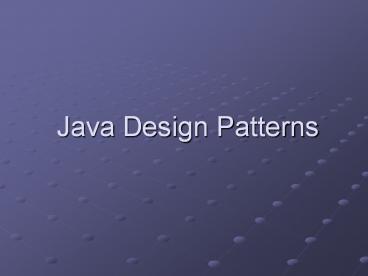Java Design Patterns - PowerPoint PPT Presentation
Title:
Java Design Patterns
Description:
Java Design Patterns What are design patterns? the best solution for a recurring problem a technique for making code more flexible by making it meet certain criteria ... – PowerPoint PPT presentation
Number of Views:455
Avg rating:3.0/5.0
Title: Java Design Patterns
1
Java Design Patterns
2
What are design patterns?
- the best solution for a recurring problem
- a technique for making code more flexible by
making it meet certain criteria
3
Why design patterns?
- The primary goal is to help improve the quality
of the software in terms of the software being
reusable, maintainable, extensible, etc. - Reduce the development time
4
Three main categories of design patterns
- Creational the creation of objects.
- Structural how one object relates with another
object. - Behavioral communication mechanism between
objects (invoke method)
5
Creational Patterns
- 1. Factory Method- Creates an instance of
several derived classes - 2. Singleton- A class in which only a
single instance can exist - 3. Abstract Factory- Creates an instance of
several families of classes - 4. Prototype- A fully initialized instance
to be copied or cloned - 5. Builder - Separates object construction
from its representation
6
Structural Patterns
- 1. Adapter- Match interfaces of different
classes . - 2. Bridge- Separates an object's
abstraction from its implementation. - 3. Composite- A tree structure of simple and
composite objects. - 4. Decorator-Add responsibilities to objects
dynamically. - 5. Facade- A single class that represents an
entire subsystem. - 6. Flyweight- A fine-grained instance used for
efficient sharing. - 7. Proxy- An object representing another
object.
7
Behavioral Patterns
- 1. Mediator- Defines simplified
communication between classes. - 2. Memento- Capture and restore an object's
internal state. - 3. Interpreter- A way to include language
elements in a program. - 4. Iterator- Sequentially access the
elements of a collection. - 5. Chain of Resp - A way of passing a request
between a chain of objects. - 6. Command- Encapsulate a command request as
an object. - 7. State- Alter an object's behavior
when its state changes. - 8. Strategy- Encapsulates an algorithm
inside a class. - 9. Observer - A way of notifying change to a
number of classes. - 10. Template Method- Defer the exact steps of
an algorithm to a subclass. - 11. Visitor- Defines a new operation to a
class without change.
8
Examples
9
Singleton design pattern
- Creational pattern
- ensure that a class has only one instance, and to
provide a global point of access to it - Example
- Class SomeClass
- static SomeClass singleTonInstance null
- static SomeClass GetInstance()
- if(singleTonInstance null)
- singleTonInstance new SomeClass()
- return singleTonInstance
10
Factory design pattern - example
- abstract class GUIFactory
- public static GUIFactory getFactory()
- int sys readFromConfigFile("OS_TYPE")
- return sys 0 ? new WinFactory() new
OSXFactory() - public abstract Button createButton()
- class WinFactoryGUIFactory
- public override Button createButton()
- return new WinButton()
- class MacFactoryGUIFactory
- public override Button createButton()
- return new MacButton()
- abstract class Button
- public string caption
11
Abstract Factory design pattern - example
- try Class.forName("sun.jdbc.odbc.Jd
bcOdbcDriver")
Connection con DriverManager.getConnection("jd
bcodbcdumy" "sa", "") - Statement stmt con.createStateme
nt() String query "SELECT FROM "
TABLE_NAME "" ResultSet table
stmt.executeQuery(query) - catch( Exception e ) e.printStackTrace()
12
Decorator design pattern
- Structural Pattern
- Avoid excessive sub-classing and gain run time
flexibility - Example
- Java.IO package
- BufferedReader br new BufferedReader(
- new InputStreamReader(
new FileInputStream(inFile))) - All derives from abstract io.Reader
13
Strategy design pattern
- Behavioral Pattern
- defines a family of interchangeable encapsulated
algorithms that receives the same input type and
provides the same output type in different
manners that can be determined in run-time. - static void Main(
- SortedList studentRecords new
SortedList()studentRecords.Add("Samual")studen
tRecords.Add("Jimmy")studentRecords.Add("Sandra"
) studentRecords.SetSortStrategy(new
QuickSort())studentRecords.Sort()studentRecord
s.SetSortStrategy(new ShellSort())studentRecords
.Sort()
14
Strategy design pattern - example
- abstract class SortStrategy
- public abstract void Sort(ArrayList list)
- class QuickSort SortStrategy
- public override void Sort(ArrayList
list) list.Sort() // Default is
Quicksort - class ShellSort SortStrategy
- public override void Sort(ArrayList list)
//list.ShellSort() not-implemented
15
Strategy design pattern - example
- class SortedList
- private ArrayList list new ArrayList()private
SortStrategy sortstrategypublic void
SetSortStrategy(SortStrategy sortstrategy)
this.sortstrategy sortstrategypublic void
Add(string name) - list.Add(name)
- public void Sort()
- sortstrategy.Sort(list)
16
Facade design pattern
- Structural Pattern
- Provide a unified interface to a set of
interfaces in a subsystem without damaging the
genric form of the sub system.
17
(No Transcript)
18
The End































